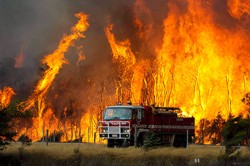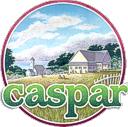Project Description
According to the State of California PEF "The main objectives of this project will be to a) remove non-native, invasive trees from Caspar Headlands State Natural Reserve, and to b) re-vegetate selected areas with appropriate native tree and shrub species. The project will foster environmental stewardship at Caspar Headlands SNR through the combined efforts of State Parks, the Caspar Community, and other State and local agencies."
The document considers this "an infestation" and, in order to get rid of it, has enlisted CalFire and fire crews from the Department of Corrections (Parlin Fork) to get it under control. The first phase of this work has been accomplished, looked like this in 2003.
After the first wave of felling took place in early 2009, it looked like this:
All that ocean and sky where the black outline is shows the view (from the Caspar Inn) that the Fire crews gave back to Caspar. Over the winter of 2010, most of the remaining "weeds" were felled, and the last of the trees will likely be gone by mid-summer 2010. Job well done! and THANK YOU to State Parks, CalFire, and the CDC crews.
short note to tree huggers
We all love trees, even these trees. But they were a terrible fire hazard -- see Australia in February 2009. Those of us who live nearby don't want to see this happen here.

What's worse: when they're not burning, they poison the ground, kill hummingbirds, and displace native habitat. They're bad actors. The plan is to replace these Eucalypts, once the ground has recovered, tree for tree with lower growing, native shore shrubs and trees. This is Restoration Forestry in action. You are invited to help. For more information on how a wildlife biologist thinks about these trees, see Peter Warner's indictment. |
State Parks' Mendocino District natural resources program proposes to work with local residents to facilitate the removal of invasive plants through increased cooperation and coordination, and this is an instance of that partnership. Under the direction of State Park Environmental Scientists, volunteers will remove the downed wood and then, with park staff, will plant the natives in appropriate locations on the Caspar Headlands. The newly revegetated areas will be maintained with the assistance of community volunteers.
Comments about State Parks' involvement in this project should be directed to project coordinator Angela Liebenberg, email ALIEBENBERG (at) parks.ca.gov -- substitute the cute little @ symbol. This link is cloaked for spam protection.
Wood Mining Project Ends - 2011
Most of the Eucalyptus trees in the upper grove, near the old berms along the northern boundary of the Headlands, and two major outliers across from the Caspar Inn, are gone. More than 30 cords of wood (a cord is 4' x 4' x 8', or roughly two pickup trucks full) were harvested and sold. Greg Valles and his paid team of professional buckers and splitters worked tirelessly. Dozens of hours of volunteer time went into the three-year long effort, and the most valiant of the volunteers took home firewood at the rate of two cubic feet ( 1/72nd of a cord ) per hour. The sale produced approximately $3,600 for Caspar Community. $500 of the proceeds was paid to Jughandle Creek Farm for native plants for restoration forestry on the site.
Unfortnately, some of the chunks of Eucalyptus were too large to move without power equipment (that was not allowed on the Headlands) and it would not have been economic to convert to firewood. Volunteer efforts continue with removal of Eucalytus sprouts and seedlings; these efforts appear, after two of years, appear to be succeeding.
|

